Parametric study on the ballistic performance of seamed woven fabrics
2023-07-04HngLiRuiZhngShengnnMinYiZhouJiuxioSun
Hng Li , Rui Zhng , Shengnn Min , Yi Zhou ,*, Jiuxio Sun ,**
a State Key Laboratory of New Textile Materials and Advanced Processing Technologies,Wuhan Textile University, China
b School of Materials Design & Engineering,Beijing Institute of Fashion Technology,100029,Beijing, China
Keywords:Fabric Ballistic performance Seaming technology Energy absorption
ABSTRACT
1. Introduction
The soft body armors are mostly composed of different stacked structures fabrics prepared from high-performance fibers. In a ballistic event, the flexible protective layer absorbs and consumes the kinetic energy of the projectile through fiber deformation,failure and friction between the fibers to offer ballistic protection.In most previous researches on body armor,hard ballistic materials were used,resulting in body armor that is not only heavy,but also motion-restrictive,and thus increasing the physiological burden on the wearer. To optimize the design of the soft body armor, researchers have been working to develop advanced systems with higher performance-to-weight ratios to improve the structure of body armor while ensuring ballistic performance.
Over the past decades, various innovative methods have been used to study the performance of soft body armor[1].According to the energy absorption mechanism of soft body armor, increasing the friction between the fabric-forming yarns could possibly be an effective approach. Although experimental studies have demonstrated that only a minor portion of the energy is dissipated by friction, it has a significant effect on the fabric [2]. Duan et al. [3]found that friction reduced the lateral mobility of the yarns,allowing the projectile to load and break more yarns,so that fabric with a high level of friction absorbed more energy than fabric without friction. This takes full advantage of the mechanical properties of high-performance fibers and facilitates the energy absorption of the fabric [4—7]. However, some researchers have found that fabric ballistic performance is impaired when inter-yarn friction increases over a critical value[8—10].Therefore,generating reasonable friction between the weft and warp yarns is beneficial to fabric energy absorption and the ballistic performance of the fabric will be improved.
To increase the friction between yarns to limit the mobility of yarns, researchers have studied many methods, the simplest of which is to weave tight fabrics to increase yarn crimp.Calvin et al.[11] manufactured woven fabrics with different cover factors,attempting to correlate the ballistic performance with weave tightness. They found that tightly-woven fabrics showed a slower transverse wave speed and a lower specific energy absorption value than loosely-woven fabrics.This is because highly undulated yarns in a tightly-woven fabric lead to a decreased initial tensile modulus,and therefore the sample target is more suspectable to have stress concentration on the impact point [12]. Besides, chemical treatment has also been widely used to improve the energy absorption properties of woven fabrics. One of the approaches is to treat the woven fabrics with shear thickening fluid(STF)[13—17].It has been reported that the treated fabrics exhibit better energy absorption capacity compared to the untreated fabrics, and the effect is more noticeable when STF deeply penetrates between the yarns [18].However,some literature pointed out that STF-treated fabrics have an almost unprotective effect when the impact velocity exceeds a certain critical value [8,10]. In addition, other approaches such as the plasma particles [19,20] and sol-gel [21]. Some of the recent literatures reported that grafting ZnO nanorod [22] is an effective method to roughen the fiber surface and consequently constrains the yarn mobility when subjected to both low-and high-speed impacts.
While these approaches effectively increased the antipenetration properties of flexible fabrics, several studies have shown that the chemical treatment inevitably damaged the mechanical properties of the fibers,reduced the fabric flexibility[23],increased the weight of the fabric[24,25],and affected the wearing comfort of soft body armor.Some researchers have proposed to use different new high-performance fibers, such as poly-p-phenylene braced benzodiazole(PBO)fibers[26,27]and poly-2,5-dihydroxyl-1,4-phenylene pyridobisimidazole fibers (M5) [28]. However, the development of new high-performance fibers requires a huge investment of human and material resources,and is time-consuming and risky.In contrast,fabric tissue modification better conforms to the concept of enhancing performance and reducing weight in soft body ballistic layers.
Based on this concept, some researchers have adopted the textile technology to composite the leno structure and plain structure to enhance the interweaving resistance of warp and weft yarns of aramid woven fabrics, and the results of the pull-out test showed that the incorporation of the leno structure enhances the grip performance of warp yarns on weft yarns and effectively limits the slipping between yarns [29]. Bilisik and Korkmaz [30] used nylon 66 as seaming thread to seam the aramid fabric, and the results of ballistic experiments showed that the backface signature(BFS) of the seamed panels is less pronounced than those of the unseamed panels. Zhou [31] also pointed out that a reasonable increase in the density of seaming lines in seamed panels can significantly increase both the energy absorption value and the SEA value of plain fabrics.
Compared with previous studies, we parametrically investigated the effect of seaming distance, seaming orientation and different seaming materials on the ballistic performance of plain fabrics based on the seaming technique. The actual effect of this approach on improving the ballistic performance of plain weaves is explored through extensive research on the seaming technique.Five ballistic experiments are conducted on different fabric samples with impact velocities of 230 m/s and 400 m/s. The ballistic performance of the samples is characterized by specific energy absorption (SEA) values. The purpose of this paper is to gain further insight into the basic mechanism of the seaming technique to enhance the ballistic performance of aramid plain fabrics and to provide a reference solution for the optimal design of soft body armour.
2. Material properties
The plain fabrics were made of Kevlar®29 and Tekmilon®I multi-filament yarns,respectively.All of the fabrics have the same thread density of 70 threads/10 cm. Kevlar® 29 and Tekmilon® I multi-filament yarns have a linear density of 1670 dtex and 1300 dtex, respectively. Cotton thread was used for lock-stitching the fabric in different directions.The engineering constants of breaking strength and modulus in Gpa were given in Table 1.The velocity of the stress wave in Kevlar®29 and Tekmilon®I multi-filament yarns are 6977 m/s and 9605 m/s,respectively.Schematic diagrams of the lockstitch are shown in Fig. 1(a), where two seaming threads interlock with each other to form a stable structure.Fig.1(b)shows the seamed Kevlar plain weave with plain weave and seamed regions zoomed-in. In the seamed region, the brown cotton thread penetrates the fabric-forming yarns and therefore generates tiny gaps within the yarn structure. In this study, a comprehensive parametric study on the ballistic performance of seamed fabrics will be performed.Table 2 shows the specifications of the different fabric samples.

Table 1Yarn and seaming thread properties.
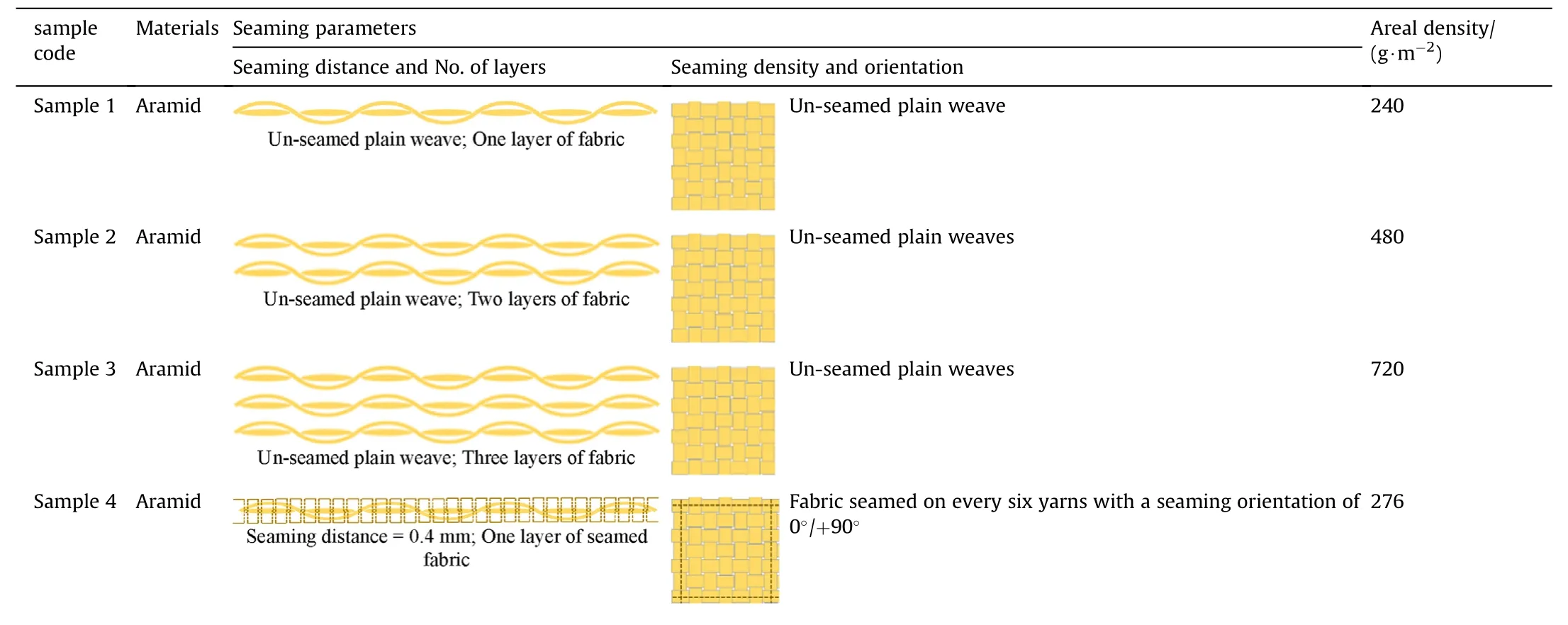
Table 2Specifications of seamed and unseamed fabrics.
3. Testing of fabric properties
3.1. Yarn pull-out tests
The purpose of the yarn pull-out tests were to quantify the resistance of plain weaves and seamed fabrics to pull-out forces.When projectiles impact a dry woven fabric,yarn pull-out is often observed on the sample target. This phenomenon prevents highperformance fibers from fully realizing their mechanical properties and consequently lowers their impact resistance. In addition,based on the principle of energy conservation, the energytransformations that occur during the ballistic event can be represented by[33].
These formulas indicate that the energy expended in overcoming friction is a major mechanism of energy absorption during the ballistic event. If we neglect the effect of air drag on the projectile loss,inter-yarn frictional sliding during pull-out is one of the major contributors to energy absorption. It is also believed that increased inter-yarn friction enables more yarns to engage with the impacting projectile, which significantly increases the amount of strain and kinetic energy deposited on the fabric target. Kirwood et al. [34,35] built a semi-empirical model to predict the energy dissipated by yarn pull-out during a ballistic event. They quantitatively correlated the yarn pull-out behavior and fabric energy absorption capacity. Numerous approaches have been used to increase the inter-yarn friction of the plain weave. The chemical treatments include but not limited to STF, plasma, ZnO nanowire,rubber, and graphene oxide. An improvement in the ballistic performance is always correlated with an increase in yarn pull-out force. Therefore, the yarn pull-out test is useful in characterizing the appreciable friction between the weft and warp yarns, serving to provide an intuitive prediction of the fabric performance during a ballistic event.
In this section, yarn pull-out tests were performed based on sample 1 in Table 2 to characterize the influence of thread seaming on yarn-yarn friction. One of the commonly used methods to perform a yarn pull-out test is to clamp the lateral sides of the sample target,leaving the bottom free.One problem with using this method is that the sample target will have in-plane shear deformation prior to the initiation of yarn pull-out. This in-plane deformation would influence yarn pull-out force and decrease the initial modulus of the load-displacement curve, contributing to more random data. To avoid this, we clamp the bottom of thespecimen,leaving the lateral sides free.Schematic diagrams of the yarn pull-out method are shown in Fig. 2(a). Apart from sample 1,several other samples were created by seaming lines on sample 1,which are shown in Fig.2(b).Each sample was repeated ten times.samples were cut into 6 × 12 cm. The length of the fabric zone is 6 cm.Yarn tails were left on the top(3 cm)and bottom(3 cm)sides.A slot was retained for the very yarn to be pulled out on the bottom side while the rest of the tails were clamped by a bottom jaw. The upper jaw grips the selected weft yarn and moves at a constant rate of 250 mm/min.

Fig. 2. (a) Schematic diagram of the yarn pull-out test (b) samples with a different number of seaming lines.
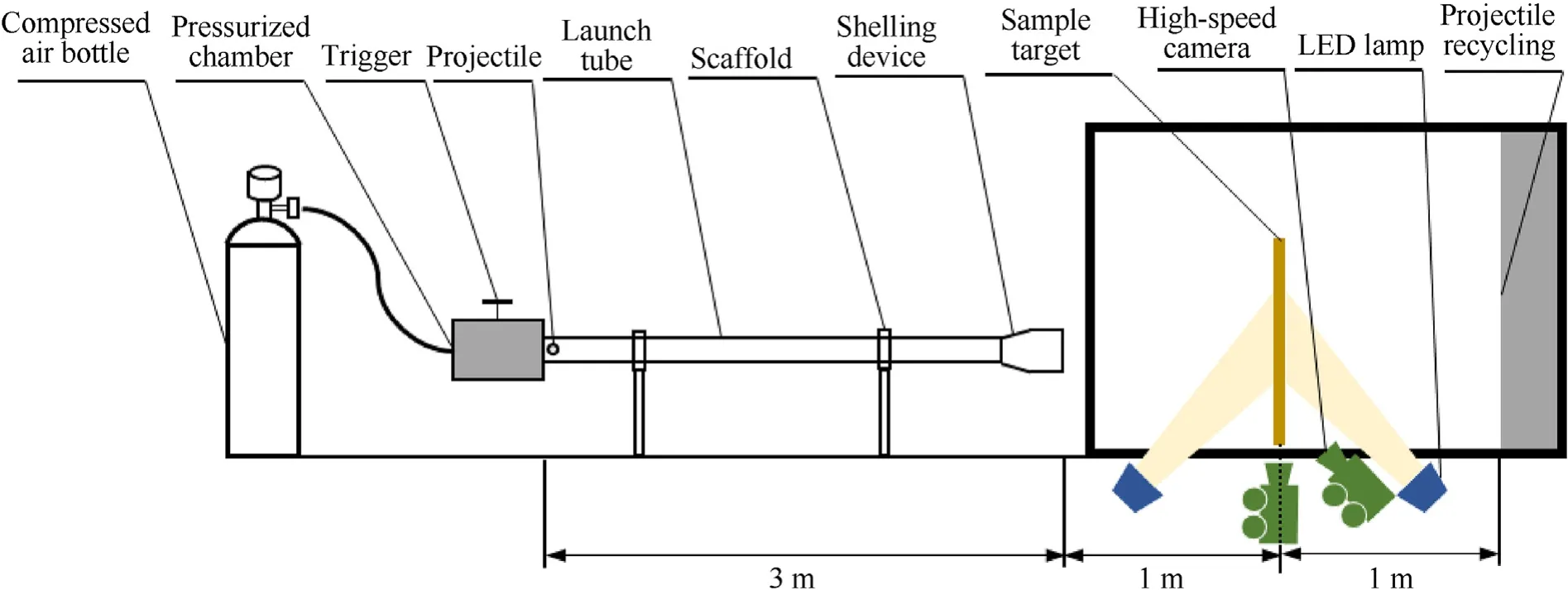
Fig. 3. A schematic diagram of the set-up for the ballistic test.

Fig. 4. The schematic diagram (a) of the corner-clamped frame and the trajectory (b) of a projectile.
3.2. Ballistic test
Fig.3 shows the set-up used for ballistic penetration tests.In this ballistic apparatus, a steel sphere of diameter 8 mm and mass 2 g was used to impact the sample target. As the gun barrel was not rifled,sabot was used to retain the trajectory of the projectile. The projectile is propelled by compressed gas, and two impact velocities, 230 m/s and 400 m/s, were used in this study. A Photron FASTCAM SA-Z high-speed camera was used to analyze the backlit profile view of the fabric during ballistic impact and to measure the impact and the residual velocities of the projectile.Fig.4(b)shows the trajectory of a projectile before and after fabric penetration.The images were recorded at a frame rate of 20,000 fps,a resolution of 512 × 512 pixels and an exposure time of 8.8 ms. The velocity can then be obtained by identifying the distance between the adjacent projectiles. The energy loss of the projectile can be determined by
where ΔEis the kinetic energy loss of the projectile,mis the mass of the projectile,andv1andv2are impact and residual velocities of the projectile, respectively.
A corner-clamped frame was designed to clamp the sample target,as shown in Fig.4(a).In this frame,the fabric was clamped at its corners to allow yarn movement during the ballistic event.Fixing bolts were through-bolted with the backplate and fastened by screw nuts. The resistance against yarn pull-out arises solely from the frictional force at the crossovers and the stitching lines.
4. Results
4.1. Yarn pull-out test
The constraining effect of the seaming lines is essential to improve the inter-yarn friction.The yarn pull-out tests were used to quantify the inter-yarn friction, and the constraining effect was characterized by measuring the force value required to pull the yarn out of seamed and unseamed plain fabrics. Fig. 5 shows the force-displacement curves of the yarn pull-out behavior and the peak load force at the same load rate using the aforementioned method. The curves indicate that the pull-out force of the seamed samples is significantly greater than that of the unseamed samples.It is also found that the maximum pull-out force increases with the number of seamed lines, suggesting that the inter-yarn friction is increased due to the fabric being seamed.From the curves in Fig.5,we can see that the peak pull-out force of the three seaming lines sample is the maximum at 46 N,which is approximately twice and ten times greater than that of the one seaming line sample and the PW (plain weave without thread seaming), respectively.
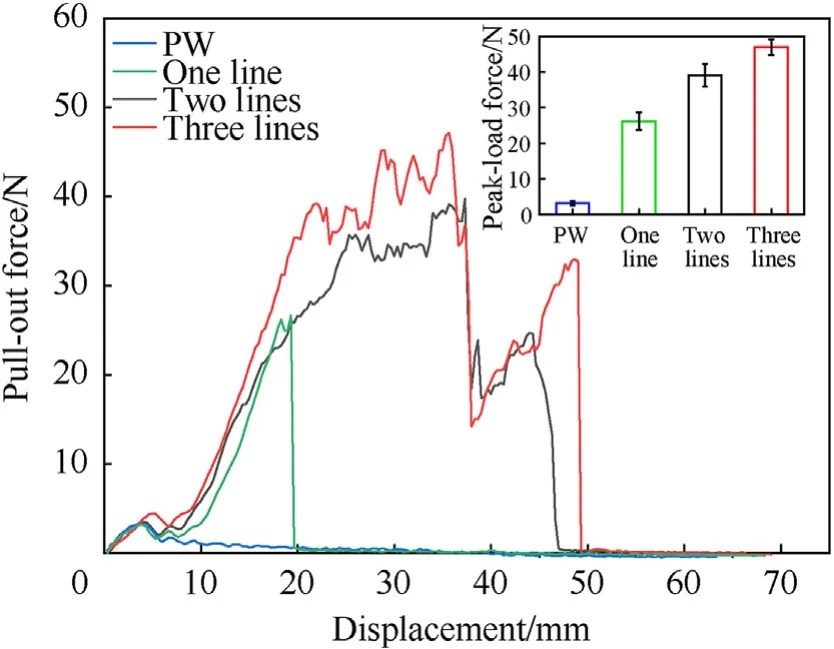
Fig. 5. Pull-out force as a function of displacement for the seamed and un-seamed samples.

Fig. 6. Specific energy absorption of the seamed and the non-seamed samples at impact velocities of approximately 230 m/s: (a) Seaming density; (b) Seaming distance; (c)Seaming orientation; (d) Seaming materials.

Fig. 7. Specific energy absorption of the seamed and the non-seamed samples at impact velocities of approximately 400 m/s: (a) Seaming density; (b) Seaming distance; (c)Seaming orientation; (d) Seaming materials.
4.2. Parametric study of the seamed fabrics
This section describes the ballistic tests performed on the samples using the method described in Subsection 3.2.It had to be noticed that the seaming threads add to the weight of the fabric.Fig. 8 and Fig. 9 displays the normalized energy absorption of the single-layer unseamed and seamed samples at impact velocities of 230 m/s and 400 m/s,the value of which is termed specific energy absorption (SEA). It could be found that the specific energy absorption of the samples at an impact velocity of 400 m/s is lower than that at 230 m/s.For example,as the impact velocity increased from 230 m/s to 400 m/s,the SEA of sample 1,sample 4,sample 5,and sample 10 decreased from 21.25 J/kg∙m-2, 26.66 J/kg∙m-2,28.80 J/kg∙m-2, and 17.64 J/kg∙m-2to 13.92 J/kg∙m-2, 17.32 J/kg∙m-2,18.58 J/kg∙m-2,and 8.93 J/kg∙m-2,respectively,a decrease of 34.5%, 34.4%, 35.5% and 49.4%. This can be explained by the energy-absorbing mechanism of the plain weave: two mechanical waves are generated when it is impacted by the projectile, one is the transverse wave, and the other is the longitudinal wave; the transmission of the transverse wave leads to the transverse displacement of the primary yarns, which drives the second yarn movement, resulting in a pyramidal deformation of the fabric. In this case,the kinetic energy of the projectile is mainly transformed into the kinetic energy and strain energy of the fabric. In the seamed samples,the constraint of the sewing lines makes the effect of this energy absorption mechanism more pronounced.However,as the impact velocity increases well beyond the ballistic limit(the critical velocity of projectile penetration fabrics),the fabric absorbs the kinetic energy of the projectile through fibers failure and responds inelastically, resulting in a reduction of the fabric's energy absorption efficiency.

Fig. 8. Fabric deformation at the impact velocity of approximately 230 m/s and 400 m/s: (a), (c) Sample 1; (b), (d) Sample 10.

Fig. 9. Penetration images of different samples at the impact velocity of approximately 230 m/s and 400 m/s: (a), (c) Sample 1; (b), (d) Sample 10.
4.2.1. Effect of seaming density on the energy absorption of the samples
Different seaming densities significantly affect the energy absorption of the seamed samples.sample 1,sample 4,sample 5,and sample 10 represent the seamed samples at different seaming densities, the specifications shown in Table 2. It can be seen from Fig. 6(a) that the sample 10 exhibits inferior energy absorption capacity compared with other seamed samples, and the energy absorption shows a trend of increasing and then decreasing as the density of the seaming lines increases. The most significant increase in energy absorption was detected in the sample 5, followed by sample 4 and sample 10. For example, The sample 5 exhibits the highest specific energy absorption when the impact velocity is 230 m/s, showing an improvement of 35.5% in energy absorption capacity compared to the sample 1. Among all the sample targets, it was also found that the most-densely seamed fabric (sample 10) appears to be least protective. This is explained as follows: when the project impacts the fabric, the yarn displacement in the plain weave is effectively limited since the weft and warp yarns are constrained by the seaming threads, which enables more yarns to absorb the kinetic energy of the projectile through yarns failure, thus minimizing the possibility of “windowing” and yarn pull-out, and contributing to the energy absorption ability as well as enhancing the ballistic performance of the fabric.The fabric energy absorption increases with the density of the seaming lines, but when it is extremely dense, overconstraining the yarn mobility resulted in the early failure of the primary yarns.This explanation is supported by Zeng et al.[35]and Duan et al.[36]in their investigation of the finite element analysis.Two exemplary examples are presented for comparison:Tapie et al.investigated the effect of uniaxial pre-tension on the ballistic performance of plain weave. They found that at higher impact velocities,fabric performs better under lower pre-tensions absorb more energy. This is because pre-tension restrains yarn movement, and therefore decreases the energy absorbed by the fabric[37];Lu et al.found that the specific energy absorption of the single-ply and 10-ply STF impregnated fabric panels was 44.8%and 64.1%lower than that of their neat counterparts at the impact velocity of 500 m/s,respectively. The inferior performance was attributed to the overconstraint of the primary yarns imposed by STF impregnation[38].The results provided by these literature can be properly used to illustrate the inferior ballistic performance of sample 10 and the working mechanisms of yarn constraint during a ballistic event.
Fig.8 shows the fabric deformation of sample 1 and sample 10 at projectile impact velocities of 230 m/s and 400 m/s, respectively.The fabric deformation is more obvious at low speed compared to high speed impact, which on the one hand also explains the fact that the fabric energy absorption decreases at high speed impact.It was also found that yarn pull-out occurred mostly in the unseamed sample (sample 1), indicating that the seaming lines provided a restraining to the yarns and hindered yarns pull-out. In addition,the deformation of the seamed sample(sample 10)at 230 m/s was significantly less than that of sample 1,which was due to the stress concentration phenomenon in the fabric caused by the overconstraining of the yarns, forcing the yarns to break prematurely.The perforation images of different fabrics after projectile impact are shown in Fig. 9. It is obvious that the pull-out phenomenon of the samples at 400 m/s is not obvious compared to 230 m/s.Due to the increasing velocity, the primary yarns of sample 1 failure to capture the projectile, the yarns are suddenly pulled and then broken,which causes the yarns to be contracted rather than pulled out (Fig. 9(c)). From Fig. 9(a), the energy absorption of the unseamed fabric is primarily realized by yarns pull-out.Because of the weak constraint between the yarns, when the projectile impacts the fabric, the yarns are unable to carry the projectile load,making it easier for the projectile to penetrate the fabric through the fabric “windowing”, so the energy absorption of the fabric is unapparent.In the seamed samples,the fabric dissipates the kinetic energy of the projectile by yarns failure and pull-out because the constraining effect of the seaming threads limits the yarn's slip.The greater the density of the seaming lines,the more pronounced the yarn fracture, as in Fig. 9(d). This corresponds to the fact that the energy absorption of the seamed samples is greater than that of the unseamed samples in Fig. 6.
The error bars represent the standard deviation values.It can be found that the energy absorption of the plain weave has the least dispersion and the dispersion of the energy absorption values of the seamed samples increases with the width between the two seaming lines.This basically depends on the impact locations of the projectile. When the impact location is at the yarns directly, the projectile causes fiber failure and contributes to the energy absorption of the target; when it is between adjacent yarns, the projectile pushes the yarns aside and causes the energy absorption of the target to decrease.For seamed samples,the number of seam lines has a significant effect on the dispersion of the energy absorption values. Compared with the projectile impacting the seaming lines gap, when the projectile impacts the seaming lines,the probability of yarn failure is higher,and the fabric absorbs more energy.A densely-seamed sample is more likely to have the impact location on the seaming line than a sparsely-seamed sample,reducing the dispersion of energy absorption values.
4.2.2. Effect of seaming distance on the energy absorption of the samples
In the seaming process,it should be noted that the seaming distance is no greater than the width of a single yarn(1.4 mm).Based on the minimum seaming distance of the embroidery machine(0.4 mm),the seaming distances of 0.4 mm,0.8 mm,1.2 mm,1.6 mm were designed. On the one hand, the effect of seaming distance on the anti-impact performance of the seamed fabric was studied, on the other hand,the weight of the seamed samples was also relieved.Figs.6(b)and Fig.7(b)show the specific energy absorption(SEA)of samples with various seaming distances for the same seaming lines density at impact speeds of 230 m/s and 400 m/s. From Fig. 6 and Fig. 7, we can see that the SEA of samples increases and then decreases as the seaming distance becomes narrower. At the impact velocity of 230 m/s, The SEA of samples 5, 11, 12, and 13 were 28.8 J/kg-2,39.77 J/kg-2,36.29 J/kg-2,and 32.48 J/kg-2,respectively,which was approximately 35.52%, 87.15%, 80.18%, and 55.34%improvement than that of sample 1.At the impact velocity of 400 m/s, the improvements in SEA are 23.22%, 70.88%, 61.82% and 43.78%greater than that of sample 1,respectively.The results indicate that a reasonable seaming distance contributes to inter-yarn constraint and synergy, which is beneficial to the fabric's ballistic performance.However, when it is too narrow, the excessive density of seaming threads on the yarn results in a decrease in the energy absorbed by the fabric.
Fig.10 and Fig.11 shows the deformation shows the penetration images of the samples with various seaming distances at an impact velocity of about 230 m/s and 400 m/s. It can be found that the seaming distance has an effect on the energy absorption mechanism of the seamed fabric.At an impact velocity of 230 m/s, yarns pull-out and breakage were observed for both samples,as shown in Fig. 11(a) and Fig. 11(b). In addition, the fabric deformation of sample 11 (0.8 mm) was found to be wider than that of sample 5(0.4 mm) by high-speed photographic images, as shown in Fig. 10(a) and (b). At the impact velocity of 400 m/s, the fabric deformation was more localized and the absorbed energy mainly by yarn breakage as shown in Fig. 11(c) and Fig. 11(d) however,compared with sample 11,sample 5 was completely penetrated by the projectile at 30 μs(Fig.10(c)),while sample 11 occurred at 70 μs(Fig. 10(d)), which prolonged the contact between the projectile and the fabric. This indicates that appropriately increasing the seaming distance is beneficial to avoid over-concentration of stress,enhance the strain energy of the fabric and improve the energy absorption of the samples.

Fig.10. Fabric deformation at the impact velocity of approximately 230 m/s and 400 m/s: (a), (c) Sample 5; (b), (d) Sample 11.

Fig.11. Penetration images of different samples at the impact velocity of approximately 230 m/s and 400 m/s: (a), (c) Sample 5; (b), (d) Sample 11.
4.2.3. Effect of seaming orientation on the energy absorption of the samples
The effect of seaming orientation on the seamed samples was also studied, and the energy absorption results are shown in Figs.6(c)and Fig.7(c).In this section,sewing lines were applied to the samples at angles of 0◦/90◦, -15◦/+75◦, -30◦/+60◦and -45◦/+45◦, marked as sample 5, sample 14, sample 15, sample 16,respectively. It was found that seaming orientation contributes to an increase in SEA.The sample 14(-15◦/+75◦)exhibits a peak SEA of approximately 36 J/kg∙m-2at the impact velocity of 230 m/s,which is almost 169%and 124%higher than that of the sample 1 and sample 5(0◦/90◦),respectively.Similar performance was observed at the impact velocity of 400 m/s. Fig.12 records the penetration images of various samples by the projectile. It can be found that when the seaming threads are applied to the fabric at an orthogonal angle(sample 5(0◦/90◦)),the samples are more likely to be pulled out after being impacted by the projectile, and the primary yarns cannot support the impact of the projectile. When the seaming threads present a certain angle(sample 14(-15◦/+75◦)),the effect of the seaming threads makes more yarns participate in the impact of the projectile,and the yarns tend to absorb the projectile kinetic energy through fracture.These data show that changing the angle of seam lines contributes to the energy absorption of the seamed sample.When the stitches rotate at a certain angle,both the single yarn and adjacent yarns are constrained by the seaming threads,which improve the friction and synergy of inter-yarns and increases the energy absorption of fabric.

Fig.12. Penetration images of different samples at the impact velocity of approximately 230 m/s and 400 m/s: (a), (c) Sample 5; (b), (d) Sample 14.
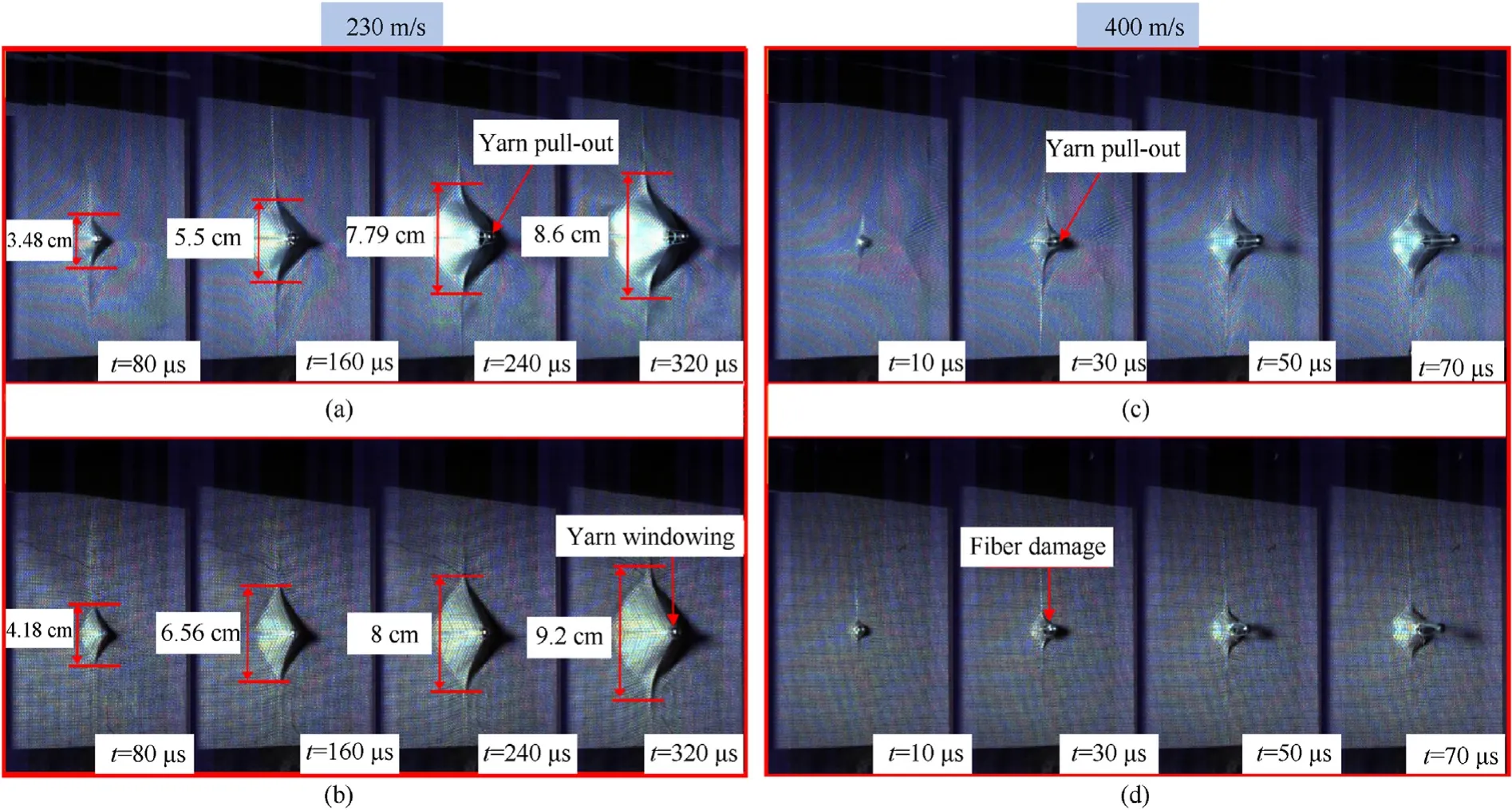
Fig.13. Fabric deformation at the impact velocity of approximately 230 m/s and 400 m/s: (a), (c) Sample 17; (b), (d) Sample 18.
4.2.4. The effect of material on the energy absorption of the samples
It is well known that the soft body armors are made from highperformance fibers and the most used are aramid and ultra-high molecular weight polyethylene (UHMWPE). Figs. 6(d) and Fig. 7(d) shows the specific energy absorption (SEA) capacity of UHMWPE and aramid samples at impact velocities of 230 m/s and 400 m/s.The comparison shows that the SEA of UHMWPE samples is greater than that of aramid for both the seamless and seamed samples. Where, at 230 m/s, the SEA of UHMWPE unseamed sample (sample 17) and seamed sample (sample 18) are 24.21 J/kg∙m-2and 26.4 J/kg∙m-2, respectively, which are 114% and 150%of that of aramid unseamed sample(sample 1)and seamed sample(sample 10).At 400 m/s,the SEA of sample 17 sample 18 are 14.61 J/kg∙m-2,17.1 J/kg∙m-2, which are 104% and 191% of sample 1 and sample 10, respectively. In addition, the SEA of all UHMWPE seamed samples are greater than that of unseamed samples,however,the contrary results are observed in the aramid samples.This indicates that the constraining effect provided by seaming is better available in UHMWPE, which is mainly related to the mechanical properties of UHMWPE.
Fig. 13 and Fig. 14 show images of fabric deformation and penetration of different polyethylene samples. As can be seen in Fig. 13, the range of deformation of the seamed samples at low speed is significantly more global than that of the unseamed samples,and also decreases the yarn pull-out,while yarn breakage is more pronounced for the seamed samples at high speed impact,as can also be seen in the images of the samples penetration in Fig.14.

Fig.14. Penetration images of different samples at the impact velocity of approximately 230 m/s and 400 m/s: (a), (c) Sample 17; (b), (d) Sample 18.
4.2.5. Energy absorption capacity of multi-layer fabrics and seamed fabric panels
To further investigate the ballistic resistance of the seamed plain weaves, ballistic tests were conducted on multi-layer fabrics and seamed panels. In the study, the seamed plain weaves (sample 5)were superimposed up to form double-layer(sample 6)and triplelayer (sample 8) systems. In addition, to reduce the length of the seaming thread, single-layer plain fabrics (sample 1) were superimposed up and seamed together to form seamed panels(sample 7 and sample 9). Fig. 15 shows the bar charts of the SEA at impact velocities of 230 m/s and 400 m/s.The flexible systems absorb less energy at high impact velocities and the energy absorption of a flexible fabric system increases with the number of ply layers.However, in terms of specific energy absorption, the multi-ply systems are not sensitive to the number of plies. From the results in Fig.14,the SEA of sample1 increases only slightly as the number of fabric layers at the impact velocity of 230 m/s, and sample 3 achieved a maximum value of 24.75 J/kg∙m-2.Similar trends were also observed on sample 5, sample 6 and sample 8. Interestingly,the seamed panels show better performance than the superimposed single-ply fabrics at all velocities.For instance,the SEA of sample 7 is approximately 156%greater than that of sample 6,and more than 200%that of sample 2.In addition,it was found that the SEA of all samples was less at the impact velocity of about 400 m/s compared to that at about 230 m/s.It is concluded that the flexible systems absorb less energy at high impact velocities.
Fig.16 displays the images of sample 3,sample 8 and sample9 at the impact velocity of 230 m/s. Fabric deformation and yarn pullout were clearly observed by the high-speed camera during the ballistic event. As shown in Fig.16(a), as the projectile progresses,the shape of the fabric deformation changes from pyramidal to square due to the pull-out of primary yarns.From the above images,we can find that the pull-out of the primary yarns is most evident in sample 3 with the projectile impact time. At time 320 μs, for instance, the primary yarns were pulled to a great extent on the sample 3, while the sample 8 were completely penetrated and caught by the impacting projectile. This indicates that when the projectile impacts fabric at low velocities, the penetration of the sample 3 is caused by pull-out without fiber failure(Fig.16(a));the penetration of seamed sample 8 is caused by the dual mechanism of fiber failure and yarn displacement (Fig. 16(b)). Compared to sample 3, the pull-out of primed yarns in sample 8 was not only delayed but also to a lesser extent,which confirms the constraint of seaming on yarn mobility; the seamed panel sample 9 prevented the impacting projectile, so there were not any markers of yarn displacement and fiber failure on fabric. The transverse deformation width of the fabric indicates that the width of the deformation of the seamed sample is wider than that of sample 3.It is because when the projectile impacts the fabric, the primary yarns drive more secondary yarns to move,expanding the deformation area of the fabric and increasing the fabric energy absorption, and hence,the inter-yarn friction increases in the seamed samples. It is noteworthy that the seamed panel sample 9 has the largest transverse deformation, which corresponds to the results in Fig.15(a). Therefore,the sample 9 is most protective.
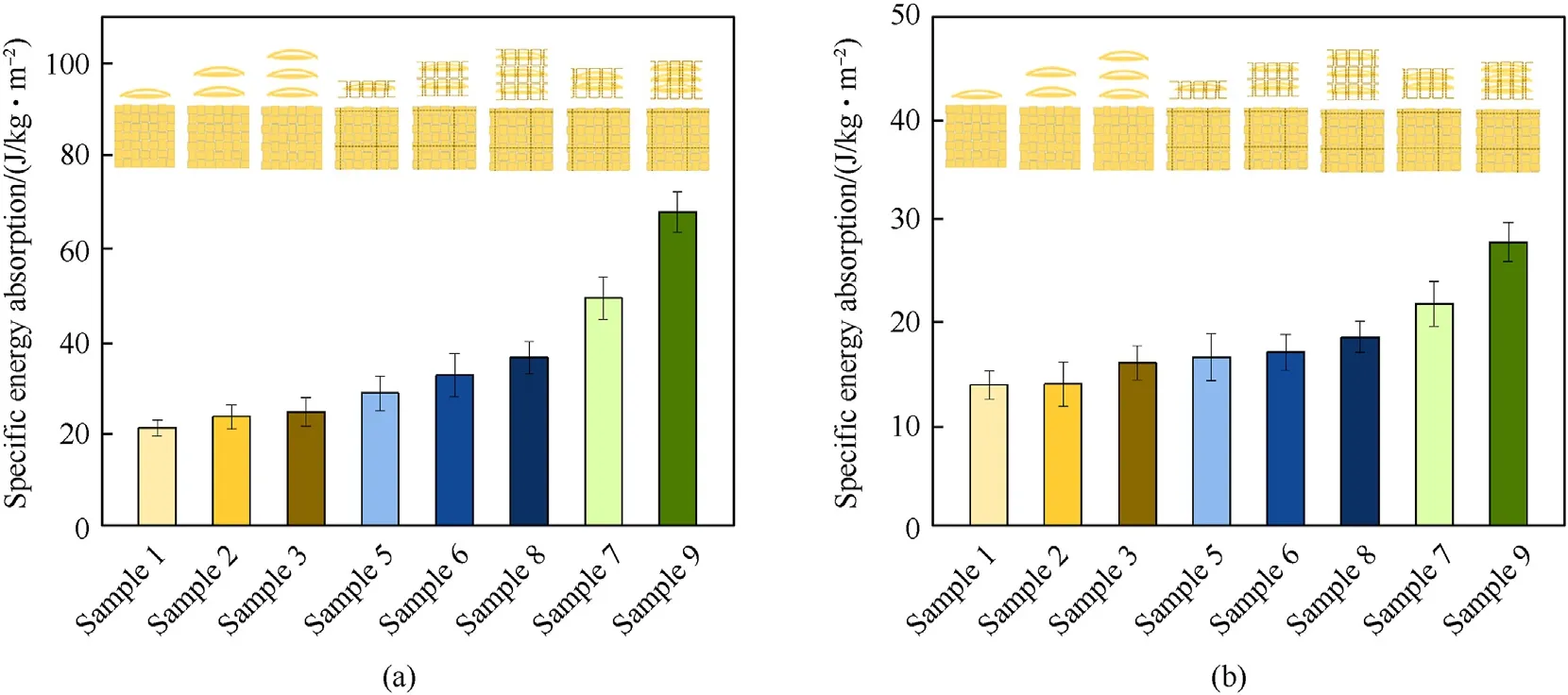
Fig.15. Comparison of specific energy absorption between seamed panels and multi-layer fabrics at impact velocities of (a) 230 m/s and (b) 400 m/s.

Fig.16. Fabric deformation of (a) sample 3, (b) sample 8 and (c) sample 9 at the impact velocity of about 230 m/s.
Clearly, both the fabric transverse deformation and yarn pullout are less pronounced for all samples at the impact velocity of 400 m/s than that at 230 m/s (Fig.16 and Fig.17). The penetration mechanism of fabric is completely caused by fiber failure.When the projectile impacts the sample 3, the duration of the projectile’s engagement with the fabric is short due to the excessive velocity of the projectile, and the primary yarns were suddenly pulled by the impact and then damaged, which leads to primary yarns being contracted rather than pulled-out.In seamed samples,the seaming lines reduce the mobility of the yarns and prevent the primary yarns from being pulled out by the projectile, the yarn displacement is limited,and the deformation of the fabric is more localized.As a result, the primary yarn may be damaged by the impact loading, allowing the projectile to penetrate the fabric.
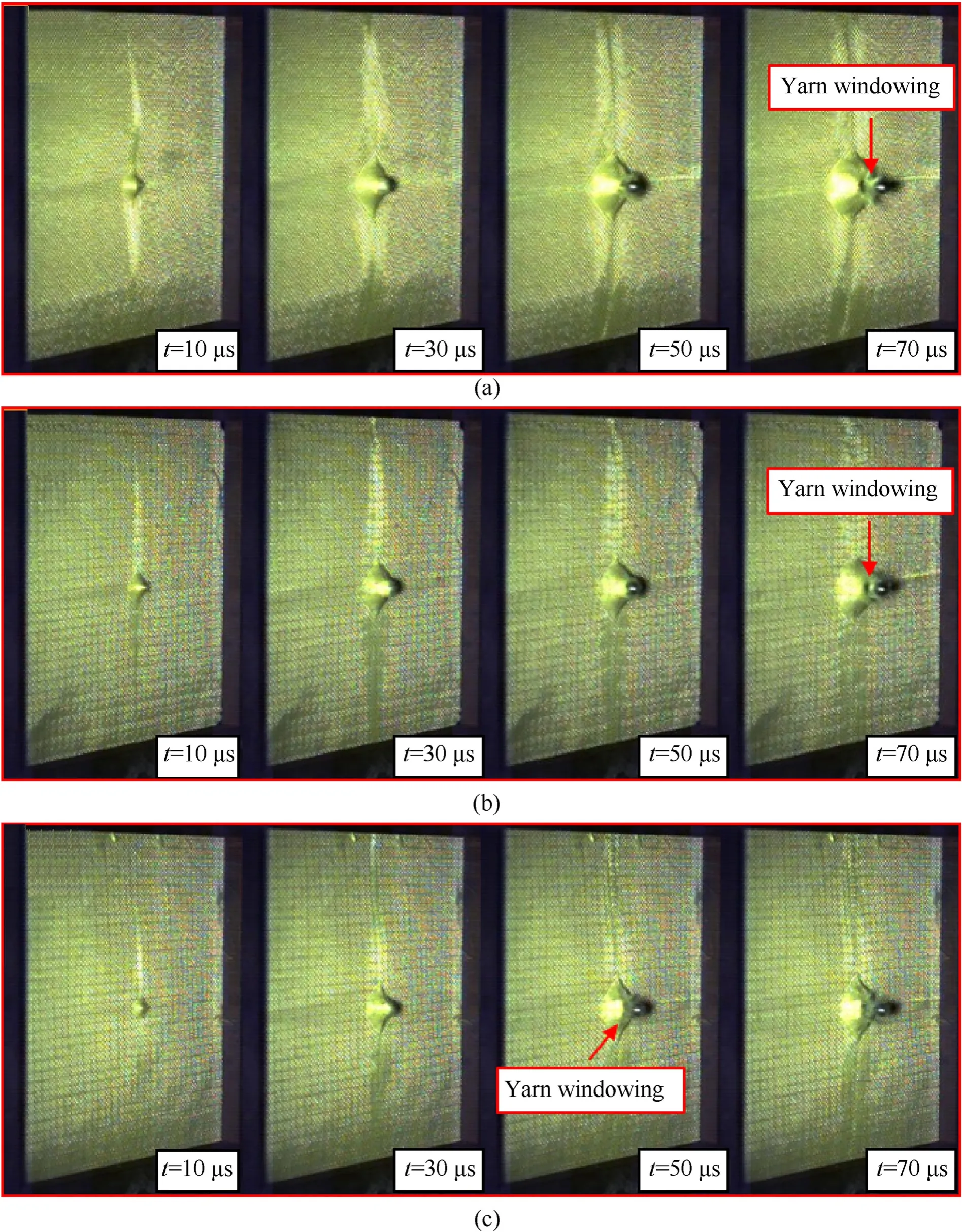
Fig.17. Fabric deformation of (a) sample 3, (b) sample 8 and (c) sample 9 at the impact velocity of about 400 m/s.
5. Conclusions
This paper aims to investigate the ballistic performance of the single and multi-layer seamed plain weave fabrics prepared by the thread seaming technique. The improvement for the effect of seaming threads between the weft and warp yarns friction force was verified by yarn pull-out force-displacement curves obtained from yarn pull-out tests, and ballistic test results were used to characterize the energy absorption capacity of different fabric samples. Based on the test results, the following conclusions are obtained:
(1) The seaming lines on the plain weave fabric provide significant additional constraints, which increases the inter-yarn friction force. The maximum values of the pull-out force with one and three seaming lines are approximately twice and ten times greater than that of PW,respectively.Besides,it can be noticed from the trend of the curves that the peak pull-out force increases with the number of the seaming lines.
(2) The ballistic test results showed that the thread seaming technique can significantly improve the energy absorption capacity of plain weave fabrics. That is, the seamed samples had better ballistic performance compared to the unseamed samples. Among them, the seamed sample (sample 11)showed the best ballistic performance in the single-layer system. At the impact velocity of 230 m/s, the energy absorption value of sample 11 was more than 187%greater than that of the unseamed samples(sample 1).In the multi-layer system, the seamed panel (sample 9) showed the most significant improvement in ballistic performance. As can be seen from the high-speed photographic images, at the impact velocity of 230 m/s, sample9 completely stopped projectile penetration compared to the other samples. In addition,the energy absorption capacity of the fabric system decreases with increasing impact velocity.
(3) The energy absorption of the seamed samples increases and then decreases with the number of the seaming lines.When the lines are over-dense, such as sample 10, the seaming technique is not conducive to fabric energy absorption. This is mainly a consequence of the over-constrained yarn mobility. The same reason explains the effect of seaming distance on the fabric system energy absorption in the thread seaming technique, where the fabric sample absorbed the most energy when the seaming distance was 0.8 mm.It was also found that the ballistic properties of the seamed fabrics are most favorable when the seaming orientation is -15◦/+75◦. In addition, compared to aramid, the thread seaming technique was more sensitive to the improvement of ballistic properties of the UHMWPE aramid plain weaves.
Declaration of competing interest
The authors declare that they have no known competing financial interests or personal relationships that could have appeared to influence the work reported in this paper.
Acknowledgments
This work was supported by the National Natural Science Foundation of China (11902008) and Hubei Province Science and Technology Project (2021BAA069).
Appendix

Table A1Impact and residual velocities values for various impact velocities.
杂志排行
Defence Technology的其它文章
- Defence Technology
- Joint target assignment and power allocation in the netted C-MIMO radar when tracking multi-targets in the presence of self-defense blanket jamming
- Design and dynamic analysis of a scissors hoop-rib truss deployable antenna mechanism
- Structural design and modal behaviors analysis of a new swept baffled inflatable wing
- Cooperative trajectory optimization of UAVs in approaching stage using feedback guidance methods
- An improved four-dimensional variation source term inversion model with observation error regularization
